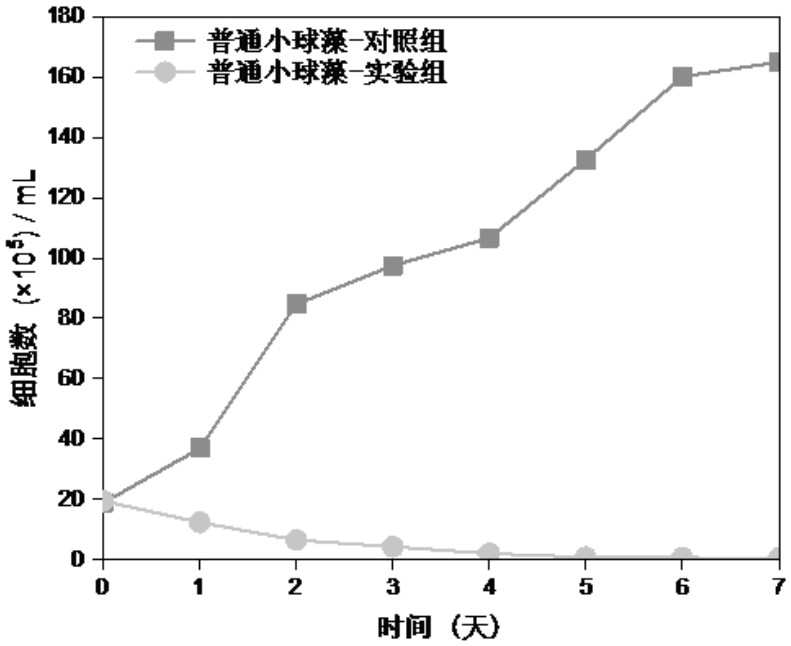Algae inhibition material and application thereof in soilless culture
A technology of soilless cultivation and raw materials, applied in the field of algae inhibition, can solve the problems of poor broad-spectrum, unstable properties, and difficult extraction of compounds, and achieve the effects of low price, simple preparation method, and increased stability
- Summary
- Abstract
- Description
- Claims
- Application Information
AI Technical Summary
Problems solved by technology
Method used
Image
Examples
Embodiment 1
[0059] This embodiment is used to illustrate the inhibitory performance of the same polyphenol-metal nanoparticle algae-inhibiting material on different algae:
[0060] The plant polyphenol used in this example is tara tannin (Tr), and the remaining ingredients are shown in Table 1.
[0061] Table 1
[0062] .
[0063] According to the requirements of Table 1, the above-mentioned plant polyphenol solution and the metal ion solution are added to the aqueous solution, stirred to complete the first complexation; then the first auxiliary agent and the second auxiliary agent are added to carry out polyphenol-metal nanoparticle size fixed to obtain the algae-inhibiting material. Test the inhibition of the algae-inhibiting materials in this example to Microcystis aeruginosa (Ma), Chlorella vulgaris (Ch), Scenedesmus tetrasaurus (Sq), Oocysts (Os) and Scenedesmus obliques (Sb) performance.
[0064] The test method is: the initial concentration of algae is 1 × 10 4 ~ 20 × 10 5...
Embodiment 2
[0068] This example is used to illustrate that the algae-inhibiting material formed by the same polyphenol and various metal ions inhibits Microcystis aeruginosa and Chlorella:
[0069] The plant polyphenol used in this example is tara tannin (Tr), and other components are shown in Table 2.
[0070] Table 2
[0071] .
[0072] According to the requirements of Table 2, the above-mentioned plant polyphenol solution and the metal ion solution are added to the aqueous solution, stirred to complete the first complexation; then the first auxiliary agent and the second auxiliary agent are added to carry out polyphenol-metal nanoparticle size fixed to obtain the algae-inhibiting material. The inhibitory properties of the algae-inhibiting materials of this embodiment on Microcystis aeruginosa and Chlorella were tested respectively.
[0073] The test method is: the initial concentration of algae is 1 × 10 5 ~ 6 × 10 5 The polluted water body is the test object; the experimental ...
Embodiment 3
[0075] Embodiment 3-implementation 4
[0076] Inhibitory properties of different polyphenol-metal nanoparticles used to illustrate the inhibition of Chlorella and Microcystis aeruginosa:
[0077] The composition of each embodiment is shown in Table 3.
[0078] table 3
[0079] .
[0080] According to the requirements of Table 3, the corresponding plant polyphenol solution and metal ion solution were added to the aqueous solution, and stirred to complete the first complexation; then the first auxiliary agent and the second auxiliary agent were added to carry out the polyphenol-metal nanoparticle The fixation of size obtains the algae-inhibiting materials of Examples 3 and 4 respectively. The inhibitory performance of the algae-inhibiting materials of Examples 3-4 on Microcystis aeruginosa and Chlorella was tested.
[0081] The test method is: the initial concentration of algae is 3 × 10 5 ~ 8 × 10 5 The polluted water body is the test object; the experimental group is ...
PUM
 Login to View More
Login to View More Abstract
Description
Claims
Application Information
 Login to View More
Login to View More - R&D
- Intellectual Property
- Life Sciences
- Materials
- Tech Scout
- Unparalleled Data Quality
- Higher Quality Content
- 60% Fewer Hallucinations
Browse by: Latest US Patents, China's latest patents, Technical Efficacy Thesaurus, Application Domain, Technology Topic, Popular Technical Reports.
© 2025 PatSnap. All rights reserved.Legal|Privacy policy|Modern Slavery Act Transparency Statement|Sitemap|About US| Contact US: help@patsnap.com



